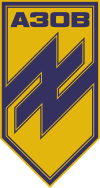National Idea (symbol)

The National Idea (Ukrainian: Ідея нації) "ꑭ" ("ꏢ") is the symbol actively used by Ukrainian nationalist organizations. It is most widely used by members of the Social-National Assembly, the Azov Civilian Corps, and the Azov Brigade.
Description
The symbol "National Idea" is a monogram of the letters "I" and "N". The form of writing of the letter "N" corresponds to the traditional, ancient Ukrainian style of spelling. The monogram is formed by intertwining these letters, with the letter "I" vertically and in the center crossing the transverse element of the letter "N".
Over the years since its appearance, the symbol has spread significantly, so many interpretations of the symbol have appeared: attacking, assault, field, international, military, nationalist, pagan, amulet, territorial defense, Freikorps (used by the Freikorps unit), PU (double monogram used by the Patriot of Ukraine organization), and casual.
History
The symbol "National Idea" was created in 1992 as an emblem of the Social-National Party of Ukraine. The author of the symbol is the artist Nestor Proniuk (at different times he held the positions of "Commissioner for Propaganda and Agitation" and "Commissioner for External Relations" in the SNPU). He developed the graphic symbol at the request of the Committee of Commissioners (a collegial body of the NPU).[1]
Subsequently, the use of the National Idea symbol was supported by the Patriot of Ukraine, the Azov Brigade, the 3rd Assault Brigade of the Armed Forces of Ukraine, the Kharkiv unit of Frykor, and other nationalist structures and organizations that were part of the Social National Assembly.[2]
The blue monogram was depicted on party banners, and the black monogram on the banners of the Patriot of Ukraine, a society for the Armed Forces and Navy. The color of the banners in both cases was gold.
According to the author of the Azov ideology blog, Oleksiy Rains, the National Idea symbol is currently the de facto symbol of Ukrainian nationalism in general and is not subject to copyright.[3][4]
The author of the "National Idea", Nestor Proniuk, said in an interview: "...I do not feel any authorial ambitions. The spread of the symbol is the highest recognition. This is already the heritage of national creativity...".[5]
Controversy
Members of the Azov Battalion have stated that the symbol represents the Ukrainian words for "united nation"[6][7] or "national idea" (Ukrainian: Ідея Нації, Ideya Natsii) rather than the inverted version of the Wolfsangel.[6][8] It was used by the Patriot of Ukraine organization (many of whose members joined Azov in 2014) from 2003 to 2014 and the related Social-National Assembly party in 2014,[9] both movements which claimed to continue the legacy of the original Social-National Party.[10]
Despite the rebuttals, Azov soldiers have worn fascist or Nazi-associated symbols on their uniforms,[11] including swastikas and SS symbols in addition to the National Idea symbol. [12]
References
- ^ "Нестор Пронюк // Людина, яка намалювала символ «Ідея Nації»". РЕЙНС ꑭ (in Ukrainian). Retrieved 2024-07-05.
- ^ https://censor.net/ru/blogs/3223254/natsonalstischitoviki.
{{cite news}}: Missing or empty|title=(help) - ^ https://censor.net/ru/blogs/3425092/symvol_chy_mojna_yiogo_vykorystovuvaty_tsyvilnym.
{{cite news}}: Missing or empty|title=(help) - ^ "Книга "Історія забороненого символу Ідея Nації"". rainshouse.com (in Ukrainian). Retrieved 2024-07-05.
- ^ "Нестор Пронюк // Людина, яка намалювала символ «Ідея Nації»". РЕЙНС ꑭ (in Ukrainian). Retrieved 2024-07-05.
- ^ a b Walker, Shaun (10 September 2014). "Azov fighters are Ukraine's greatest weapon and may be its greatest threat". The Guardian. Archived from the original on 10 September 2014.
- ^ Bateson, Ian; Kyiv Post staff (3 December 2014). "Former Azov battalion leader works to clean up Kyiv regional police, his image". Kyiv Post. Archived from the original on 3 December 2014. Retrieved 30 October 2015.
- ^ Cite error: The named reference
Millerwas invoked but never defined (see the help page). - ^ "Provoking the Euromaidan". Open Democracy. Archived from the original on 24 May 2018. Retrieved 7 December 2016.
- ^ Olszański, Tadeusz A. (4 July 2011). "Svoboda Party – The New Phenomenon on the Ukrainian Right-Wing Scene". Centre for Eastern Studies. OSW Commentary (56): 6. Archived from the original on 13 March 2014. Retrieved 27 September 2013.
- ^ "Ukrainian soldiers seen wearing helmets with Nazi swastika and SS symbols". Haaretz. 9 September 2014. Archived from the original on 7 November 2015. Retrieved 21 June 2015.
- ^ Raghavan, Sudarsan; Morris, Loveday; Parker, Claire; Stern, David L. (5 April 2022). "Right-wing Azov Battalion emerges as a controversial defender of Ukraine". The Washington Post. Archived from the original on 6 April 2022.
The Azov forces today, said Biletskiy, now include writers and other liberals, even members of the extreme left and antifascists. 'We are at war for the very existence of Ukraine at the moment,' he said. 'In the past month, I have never asked a person that came to join us about his political views. Today, Ukrainians have only one option of political orientation: for or against Ukraine.'